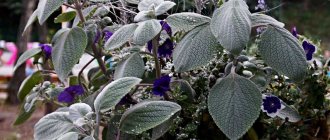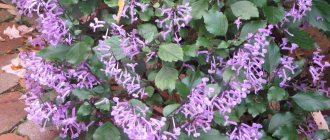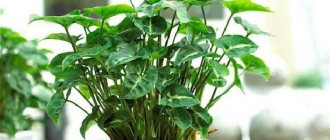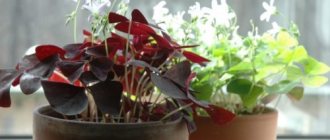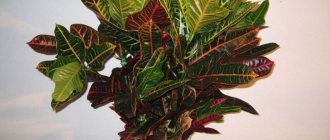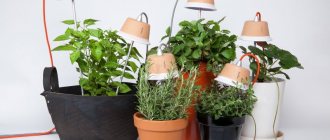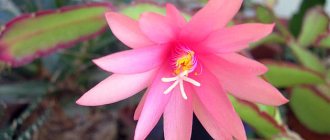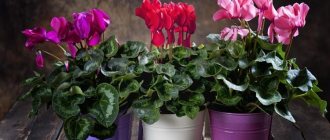Recently, a friend sent me a photo of a flower that she was given as a gift called “room mint” and was recommended to make tea from it. I immediately guessed the plant; it turned out to be my favorite plectranthus. Having started to study information about the plant in more detail, I found out that plectratus is not only a spectacular ampel. They actually make fragrant tea from it. They are also used to treat many diseases, to fight moths and even to attract money! Read more about plectranthus, or spur flower, in this article.
Plectranthus is beautiful, fragrant and healthy. © Lyudmila Svetlitskaya
general information
In nature, plectranthus is common in Asia, Africa and Australia, but it has long taken root well in our latitudes. It is also popularly called spur flower because of the specific shape of the corolla. Indoors, plectranthus blooms towards the end of winter.
Due to its characteristic aroma, plectranthus is often called homemade mint. Despite the fact that this is a flowering plant, it is valued primarily for its beautiful leaves, which form a lush and spectacular crown.
The height of the bush in indoor conditions rarely exceeds 80 cm, and usually it is even less. Plectranthus is very branched, with strong fibrous roots and ribbed shoots. But the leaves are completely different in shape, structure and color.
Photo: zelenj.ru
Room humidity and plant watering (seasonal features)
Indoor mint is very picky about air humidity; if the room has high humidity, mint tolerates being in proximity to a radiator, heater and other heating devices.
A glass of water next to the plectranthus to create a comfortable humidity level
Also, to regulate air humidification, you can place a plate of water next to the flower, or you can place wet pebbles, expanded clay or moss in the plant’s tray. In this case, make sure that the bottom of the pot does not touch the water in the pan.
Plectranthus is a hydrophilic plant, despite this, it should be watered only when the top layer of the earth dries out.
Plectranthus, with the arrival of warmth, needs to be watered more often. In the summer, it is advisable to carry out various kinds of water procedures for the flower, namely, spray the leaves or pour water from a watering can (the main thing is to ensure that the soil is not washed out of the pot).
In winter, plectranthus rests, so you need to reduce watering to a minimum .
Keep the soil moist. If you forget to water it, it will die.
Types of Plectranthus
There are a lot of species of plectranthus in nature, but not all of them are suitable for indoor growing or landscaping in the middle zone. Let's look at the most common ones in our latitudes!
Coleus plectranthus
Under favorable conditions, this neat evergreen shrub grows up to 1 m. Its strong, pubescent shoots are decorated with a purple color, and the leaves seem to be covered with a bluish coating.
Photo: pchelkinastrana.ru
Plectranthus Forstera
It is also sometimes called Indian, and is notable for its long and almost creeping shoots. In summer it is densely covered with small white flowers up to 1.5 cm in diameter.
Photo: davesgarden.com
Shrub plectranthus
This is a fairly tall herbaceous species, which sometimes grows to a full-fledged shrub. The leaves are very fragrant, with a beautiful ovoid shape. By the way, on the farm it is used to repel moths.
Photo: gallery.forum-grad.ru
Plectranthus Ertendahl
It has spectacular rounded leaf plates with an openwork figured edge and light veins. But this variety needs an increased amount of fertilizing for flowering.
Photo: pestik-tychinka.ru
Felt plectranthus
It was so named for the distinct edge on its wide, ovate leaves. This is a medium-sized shrub, up to 75 cm, and an interesting light green shade.
Photo: harrowphotos.com
Southern plectranthus
Beautiful creeping appearance with long petioles. They are glossy, without pubescence, but as if rubbed with wax. This plectranthus grows well as a hanging plant and has almost no smell.
Photo: pinterest.com
Hamedorea (50 photos): types, cultivation and care at home
Description
Plectranthus does not require special care. It grows actively at home all year round. It has long and flexible shoots. If it is planted in a pot, the length of the stem reaches about eighty centimeters in an adult. Foliage is the same size.
Depending on the type, it comes with or without a pattern. Exudes a pleasant mint aroma. Very useful in areas where moths appear. The smell of Plectranthus repels insects. Indoor mint blooms in the summer. The inflorescence is lush. The flowers are bisexual, the color is lilac, purple, white or blue. After the fruits ripen, they open and four nuts are formed inside.
Plectranthus care
Plectranthus is one of those universal favorites that do not require any special conditions or care. Lighting and regular watering – that’s all the unassuming plant needs!
Temperature
Room temperature is good throughout the year. In summer, 20-25 degrees are ideal for it, and in winter the plant lives well at 14-15. Do not lower the temperature below 12 degrees.
Photo: master-eduard.ru
Lighting
Delicate decorative leaves do not tolerate the scorching sun and may become burned. Therefore, plectranthus prefers diffused light and will grow well even in partial shade. No additional lighting is needed.
Photo: zemeljka.ru
Watering
For plectranthus, frequent and abundant watering is important, but at the same time, the top layer of soil must dry out. In the heat and winter during the heating season, periodically spray the plant with warm water.
Photo: komnatnyecvety.ru
The soil
Choose a nutrient substrate based on leaf soil and sand. Due to abundant watering, a very thick drainage layer is needed - it can occupy up to a third of the flowerpot. Take the pot itself deeper to accommodate the developed rhizome.
Photo: flori-da.ru
Fertilizers and fertilizing
Feeding is practically not needed. During the growth period, feed it with a mineral complex for deciduous plants. Once every 2-3 weeks is enough, and at other times there is no need even for this.
Photo: pinterest.es
Trimming
In order for plectranthus to bush beautifully, it needs to be periodically pruned and pinched. In the spring, at the beginning of the season, the shoots are shortened by half, and later in the process they are pinched as needed. If this is not done, the shoots will stretch and become bare.
Photo: pestik-tychinka.ru
Transfer
During the first years, plectranthus is replanted every spring, choosing a pot slightly larger than the previous one. In the future, rare transplants will suffice as needed, but it is better not to disturb the plant at all. During transplantation, the bush can be carefully divided into several parts.
Photo: serissa.ru
Date palm (50 photos): types, care and cultivation at home
How to replant a flower, step by step guide
From time to time, indoor plants must be replanted . This is caused by various reasons. It is better to transplant mint in the spring (in March), before the plant begins to grow.
Step-by-step guide for proper transplantation:
- choose a new pot (several times larger than the previous one);
- prepare the soil for replanting (moisten evenly);
- thoroughly wet the soil to remove the earthen lump and not damage the roots;
- put drainage at the bottom of the new pot and sprinkle with earth;
- insert the plant into the pot and cover it with soil (so that there are no cavities with air and 2 cm remains to the top of the pot);
- press down the earth a little ;
- water generously.
Pest and disease control
Plectranthus has good immunity, so it almost never gets sick. But with high humidity and low temperatures, even he suffers from fungal diseases. In this case, it is necessary to treat the bush with fungicides and adjust the regime. Affected shoots will have to be removed immediately.
The persistent aroma of plectranthus repels pests. It is very rare to see aphids, mites or scale insects on it. It is usually sufficient to gently wash the leaves with soapy water. If there are a lot of insects, use protective drugs!
Photo: missouribotanicalgarden.org
Epipremnum (50 photos): types, cultivation and care at home
How does the indoor plant reproduce?
Homemade mint cuttings in water
The cuttings have taken root
Cuttings are planted in prepared soil
Mint is propagated by cuttings:
- It is necessary to pinch off several stems from the plant and place them in water (The shoots must be cut so that they have several internodes).
- As soon as our stem takes root, it can be planted in a pot.
- All components must be mixed in a ratio of 1:2:1:1.
- After this, the container must be covered with glass .
- The first roots can be seen after about 1 week. As soon as the roots become up to 3 centimeters long, the cuttings can be transplanted into the ground .
To get a lush bush, you can plant several sprouted stems nearby.
Plectranthus – photo
The plectranthus genus is so diverse that you can find more than a dozen varieties that are completely different from each other. Just look how beautiful it is!
Photo: flowersweb.info
Photo: greenboom.ru
Photo: rastenievod.com
Photo: leplants.ru Photo: commons.wikimedia.org
Photo: na-dache.pro
Photo: samson-school.ru
Photo: uz.crushingplants.info
Photo: alternativeeden.com
Photo: m.alibaba.com
Photo: water-vao.ru
Photo: youtube.com
Photo: pelargoniumpl.blogspot.com
Photo: komnatnyecvety.ru
Photo: nuestraflora.com
Photo: houseplants.studleys.com
Photo: commons.m.wikimedia.org
Photo: ru.m.wikipedia.org
Photo: ethno2.ethno-botanik.org
Photo: pixabay.com
Photo: shop.zelmir.by
Photo: sortved.ru
Photo: uz.crushingplants.info
Photo: glav-dacha.ru
Photo: zen.yandex.ru
Did you like the post? Subscribe to our channel in Yandex.Zen, it really helps us in our development!
Diseases
Indoor mint diseases develop with improper care.
Leaf burns
The plant needs good lighting, but direct sunlight causes burns. They appear as brown dry spots. If they are detected, the pot is immediately removed to another place, and the affected areas are removed.
Wilting foliage
Limp and yellow leaves indicate low air temperatures. In this case, the plant is moved to another location. To make it easier to control the temperature level, you need to hang a small thermometer in the room.
Plectranthus is an unpretentious evergreen plant that is distinguished by its varietal diversity. With proper care, such bushes will delight the owner for many years.
What plants are similar to mint?
So, we have already found out how lemon balm differs from mint in terms of appearance and chemical properties, but this does not mean that you will not confuse these plants with others similar to them. If we take into account only the external similarity and do not take into account the aromatic qualities, then dead nettle (white nettle) and some other representatives of the Yamnotaceae family are very similar to mint: creeping tenacious, European sage, common dubrovnik, common odoriferous, common blackhead and catnip. Important! Most mints are hardy plants that grow very well, so there's a good chance you'll see mint in parts of the garden where you didn't plant it.
Moreover, mint itself also has many varieties, the most common of which are:
- pepper (most often bred for use in cooking, medicine or for household purposes);
- curly (characterized by a delicate aroma and the absence of a sharp cooling taste);
- Japanese (distinguished by rather large purple flowers);
- long-leaved (grown on plantations to obtain essential oil);
- meadow (presented in the form of a wild plant, which most often grows throughout the entire site);
- catnip or catnip (the most attractive species for cats, which, like lemon balm, has a slight lemon smell).
Some gardeners often confuse lemon balm and catnip, but in fact, these two plants have significant differences. First of all, the chemical composition of the oils and their quantity cannot be called the same, although the aroma of this plant is very reminiscent of lemon balm. The growing area of these plants also differs. While catnip is more often found in the forest-steppe zone, in the Crimea, the Caucasus or the Far East, mint and lemon balm prefer the southern regions. Important! Lemon balm is often called lemongrass or lemon balm, but as for the latter name, it is not entirely correct, since mint itself is considered a completely different plant, although it belongs to the same family.
Be that as it may, both mint and lemon balm have very useful properties that have a wide range of applications not only in everyday life, but also in cosmetology and medicine. Herbal teas containing these plants can both improve the tone of the whole body and have a relaxing effect after a hard day at work.
Melissa and mint - what's the difference?
Mint and lemon balm are so similar that many consider them to be one plant, known by different names.
Actually this is not true. They are “sisters”, representatives of the same family. But the properties that lemon balm and mint have differ from each other. It is especially important to know and distinguish them for those who use plants for medicinal purposes. To understand what lemon balm and mint provide, what the differences and similarities between these herbs are, it’s worth getting to know each of them in more detail.
Significant difference in chemical composition and properties
It is no secret that mint has an excellent tonic effect, and lemon balm has a good calming effect, which is largely explained by their chemical composition. Thus, mint contains a large amount of essential oils, and is also high in saturated acids (0.246 g), fats (0.94 g) and dietary fiber (8 g). In addition, the plant contains many vitamins: A, B1, B2, B3, B6, B9, C, PP, and among the minerals there are copper, manganese, calcium, phosphorus, magnesium, zinc, iron, potassium and sodium. Thanks to this composition, the difference between lemon balm and mint is also the analgesic effect of the latter, as well as its anti-inflammatory, diuretic and choleretic properties.
The chemical composition of lemon balm is in many ways similar to that of mint. Of course, it does not contain fatty acids and dietary fiber, but it consists of the same vitamins and minerals, only in a different concentration. Melissa contains vitamins A, B1, B2, B6, B9 and vitamin C, as well as the already mentioned copper, zinc, phosphorus, sodium, manganese, calcium, potassium, magnesium, iron.
